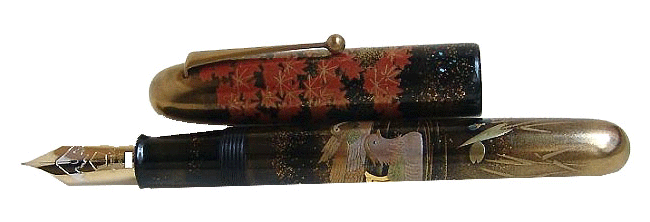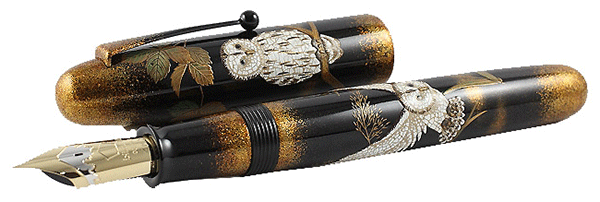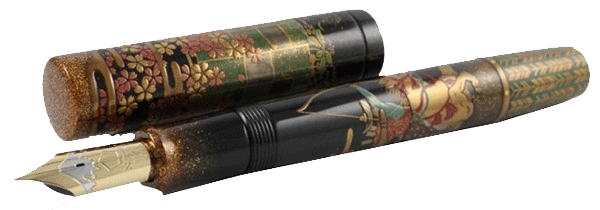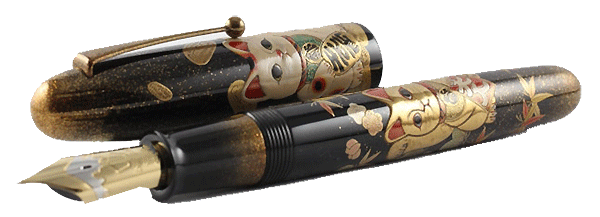|



|
NAMIKI AND PILOT MAKI-E
EMPERORS
We have been consigned this wonderful collection of NAMIKI and PILOT pens. Emperors, Yukari Royales ands Yukaris. There are Limited Editions, and pieces here that are impossible to find (well, almost). Call, or E-Mail for more information and prices. |
MANDARIN DUCK

Released in 2007, the Mandarin Duck is another highly crafted designs that Namiki is known for. This is the Emperor size pen, a handful and a very impressive writing instrument and work of art.
The use of Raden, pieces of abalone inlaid in the body of this pen creates the flower highlights. Raden is also used as a textural application along with gold fleck as seen with the image of maple leaves to the right. Autumn Maple adorns the cap while bamboo shoots up from the end of the barrel. Bamboo and pond pads below the Mandarin Ducks give variety to this composition.
|
KYLIN

A kylin is a mythical suspicious beast, once revered in ancient China. The kylin’s form is part deer, part dragon, part ox, part horse and part fish, and it was said to appear before virtuous rulers. In Japan, it was also revered as one of the four sacred beasts, alongside the phoenix, the dragon and the turtle. A symbol of good fortune, peace and prosperity, it is seen in the design of swords and their metalwork adornments.
The Kiritake (paulownia & bamboo) motif is a symbol of good fortune and noble gentility. The kylin and Kiritake are depicted with a striking and majestic finish, by using Taka Maki-e technique. |
EMPEROR OWL

The Emperor Owl fountain pen pays homage to this symbol of wisdom, luck, blessings, and success. The artist uses Rankaku Maki-e to handcraft the two identical owls using pieces of quail egg. Raden (mother of pearl) is inlaid to highlight the owls' gleaming eyes. One is perched on a tree seeking out its prey and the other depicts the owl silently flapping its wings and swooping in for the kill. |
Polar Bear

Produced in an edition of 99 pieces. This Emperor-size "flat-top" fountain pen was released just before the announcement of the creation of a polar bear refuge in the Arctic.
The pen is quite three dimensional. The ice flows, as seen above, are raised above the surface of the cap. The iceberg seen to the left seems to float off into the distance,
The ice flow incorporates two different Maki-e techniques, togidashi-maki-e (burnished Maki-e) and taka-maki-e (raised Maki-e). Togidahsi-maki-e is a method in which silver and gilded patterns are dried, re coated with Urushi, and finally burnished to a high sheen using charcoal. This style of Maki-e dates to the 7th century. The Taka-maki-e method, is applied on patterns in raised relief and dates to the 12th century. The light reflects off both the raised and burnished surface of the ice as well as the forms at the bottom of the barrel. This is one of the most labor- intensive methods used in the production of Maki-e pens.
The top of the cap is also adorned with tiny pieces of raden (abalone shell flakes), which refract different colors depending upon the angle from which the light strikes. Also notice the Big Dipper, Ursa Major, in gold dots on the side of the cap. Ursa Minor is seen at the very top.
Blue, white, silver, gold, and red form the palate for this northern motif. Hand-painted and speckled pigments are used, as well as gold and silver dust embedded in the Urushi lacquer. |
YABASUME

Yabusame pays homage to Horseback Archery, which is an ancient Japanese tradition created in the Kamkura period to help samurai hone in on their archery skills. It is a yearly ceremony in which archers clad in the hunting outfit of medieval warriors shoot at three targets as they race by on horseback.
The archer must be on horseback for it to be considered Yabusame. The rider then attempts to hit three wooden targets with turnip-headed arrows.
The pen barrel illustrates the powerful and charismatic scene of a Yabusame spring ritual, practiced in prayer for a successful crop. The adventure of the archer charging on his horse is brought to life in vivid detail with the Taka (Raised) Maki-e technique.
The Namiki Yabusame Limited Edition Fountain Pen is Emperor sized and was painted by Michifumi. There will only be 99 pieces available for the entire world. |
SETSUGEKKA

The Setsugekka, is a Limited Edition of 99 pieces. traditional Japanese phrase expressing the beauty of nature in seasons, such as in Winter snow, Autumn Moon, and Spring flowers . The essence of these scenes is captured here in elegant detail.
Skilled artisan Michifumi uses the Togidashi Taka (Burnished-Raised) method to capture beauty of the Setsugekka motif.
The winter snow crytals and traditional Japanese snowflake design was crafted using Togidashi (Burnished) and Hira (Flat) maki-e technique to give the design more depth. alongside a range of other refined Maki-e techniques.
Spring is represented by the golden-glazed Sakura cherry blossoms in full moon and is decorated on top of the cap, and further embellished with gradated sprinkles of silver powder to portray the whimsical dance of the moonlight trail for ‘autumn’.
|
Emperor Maneki-neko (Kitty)

The Maneki-neko or Beckoning Cat, is a traditional symbol of prosperity and good fortune. Maneki-neko (beckoning cat) is a figurine of a well-dressed cat that sits with a front paw raised with a beckoning pose. They are normally placed at the entrances to homes in the hope that they will act as talismans, keeping households safe and bringing good luck. These symbols are also prominently positioned at the fronts of shops to attract floods of customers and business prosperity. It is said that a cat with a raised right front paw leads to good fortune and that a cat with a raised left front paw attracts customers and business prosperity.
|
|